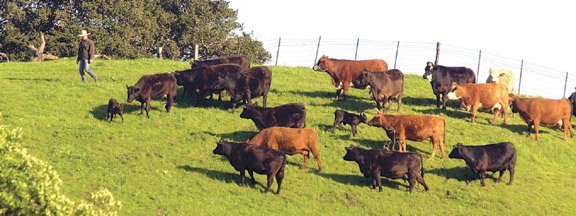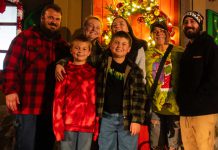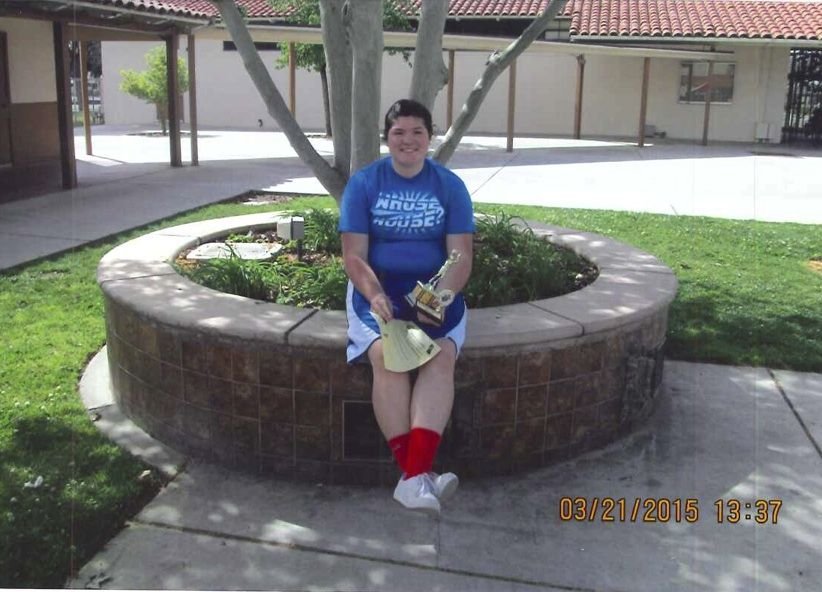A literature degree from Notre Dame University is an unusual
qualification for a cowboy, but it’s just what San Juan Bautista’s
Joe Morris needed.
A literature degree from Notre Dame University is an unusual qualification for a cowboy, but it’s just what San Juan Bautista’s Joe Morris needed.
“The objective of my education was to learn to think,” Joe said. “Thinking is definitely useful when you’re a cowboy. A cowboy is presented with all sorts of situations that are not mechanical. One needs to be able to think well and flexibly.”
Joe and his wife, Julie, run Morris Grassfed Beef, and have for the past six years sold beef directly to Monterey and San Francisco Bay Area customers. But, they think about food on a global scale.
“We try to help people think about our food system,” Joe said. “It takes a couple of gallons of diesel to produce a grass-fed steer, and more than 250 gallons of crude oil for an industrially produced steer.
“Geopolitically, your food really matters, and how you buy it is the most politically potent act you can do.”
Livestock and ranching are an important part of Joe’s ancestry. His maternal grandfather, J.J. Baumgartner, grew up on Santa Margarita Ranch – now Camp Pendleton – in Southern California before moving to San Juan Bautista to run cattle. Joe’s great-grandfather was a San Francisco butcher in the 1850s.
“We started with five customers and that has increased dramatically,” Julie said.
The Morrises estimate they had 200 customers last year and they expect to have 300 customers this year. They’ve had inquiries from people across the country who want to purchase their beef, but the Morrises discourage long-distance customers.
“We’re of the school of thought that’s tries to stay on a scale that is manageable. We don’t believe bigger is necessarily better,” Julie said. “We really believe in local food.”
And Julie added that prospective customers from afar are encouraged to find a local grass-fed beef producer.
Healthy land, food and communities
Grass-fed beef differs from factory-raised and even most organic beef in the cattle’s diet. And most cattle are fed grain, which is not their natural diet, the Morrises said.
Julie points to studies that have shown that cattle fed grass produce beef with higher levels of beta-carotene, vitamin E, Omega 3 fatty acids and other nutrients. Grass-feeding also produces beef with much less fat than traditional beef.
The Morrises’ cattle are given no hormones, chemicals, antibiotics or steroids, Julie said.
“They are never in feed lots,” Julie said, adding that some organic beef is confined in pens. “Our cattle have access to clean water and we try to manage them in a stress-free environment.”
Morris Grassfed Beef is not yet certified organic because of USDA requirements that the slaughterhouse and butcher used in processing the beef also be certified as organic.
In addition to what the Morrises consider to be a better product, they believe grass-fed beef is also better for the environment.
“One of the things we’re really proud of is we manage for native grasses,” Julie said. “We try to prevent overgrazing. We try to prevent erosion. We try to promote clean water and oak trees.”
The couple graze the cattle on approximately 8,000 acres of land, including leased space at Hollister Hills State Park, Pacheco State Park and a large private ranch.
During the spring, when grass shoots are young, the Morrises move the cattle every day to prevent overgrazing, Julie said. Other times of the year, the cows are moved every couple of days.
The Morrises base their business philosophy on a management tool called holistic management developed by agriculture consultant Allan Savory.
While working as a teacher in Washington, D.C., a friend gave Joe a copy of World Monitor magazine that contained an article about Savory’s work.
“It was an epiphany of sorts,” Joe said. “It combined my love of livestock and the land and quite directly impacts the health of the community. I decided to return to California and try to get into the cattle business.”
Julie said Savory’s approach encourages any business – agricultural or not – to write environmental, economic and social goals and to test each decision based on how it will affect those goals.
“Our goal is to manage in a way that produces healthy land, healthy food and healthy communities,” Julie said.
Subscription beef
The cattle are slaughtered at 18 months to 24 months of age at a USDA-inspected slaughterhouse in Los Banos. The slaughtered cattle are then taken to a butcher in Freedom, just outside of Watsonville, where the beef is dry-aged for 14 days, cut, wrapped and frozen. Customers, who have placed their orders in advance, pick up their beef from the butcher.
Slaughter begins in June and runs through November, Julie said. Morris Grassfed Beef is sold for $4.75 to $5 a pound.
“We try to peg ours against premium beef in supermarkets,” Joe said. “We think we’re right on par.”
The smallest amount available for order is a split half, which typically costs between $425 and $450.
“Every penny (customers) pay us goes to a family business or care of the land,” Joe said. “(Money for) industrially produced food goes to things we’re not that pleased with. The environment doesn’t become better because were eating (industrially produced food), it becomes worse.”
A split half typically has 18 pounds of steaks, seven pounds of roasts, 40 pounds of hamburger, 11 pounds of chuck and round steaks and four pounds of stew meat. Organ meat, tongue and bones are available by special request.
Frozen beef lasts up to one year, Julie said, and a split half fills about two-and-a-half shelves on a typical side-by-side refrigerator-freeze, or approximately one shelf on a horizontal freezer.
The couple lives with their two children, Sarah, 8, and Jack, 6, on Joe’s family’s 200-acre ranch in San Juan Bautista.
“When we got married, we moved back to the ranch,” Julie said. “Joe spent summers on the ranch and always wanted to be a cowboy.”
Details: Morris Grassfed Beef or to place an order www.morrisgrassfed.com or call 831-623-2933.















